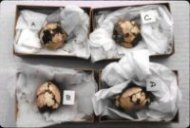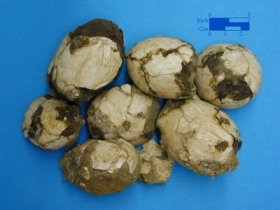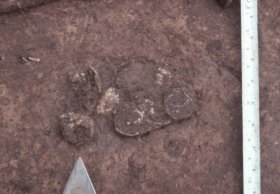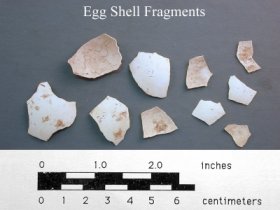Eggs

Conservator’s Notes
Sometimes archaeological excavations yield surprising objects that even the most experienced archaeologists are not expecting to find. Such an artifact was discovered during a survey on the property of St. Mary’s College in Maryland. A group of egg shells was located underneath a modern sidewalk in an area that contained colonial material. Due to time constraints in the field, the archaeologists decided to lift the group of eggs and bring them into the conservation laboratory so they could be further cleaned and examined in a more controlled environment. Lifting fragile archaeological objects takes time, skills and patience. The objects must be documented before the lift is performed in case something happens to the artifacts during the lift. The stability of the objects must be fully assessed before a lift is performed and supplies and personnel must be gathered at the site.
In the case of the eggs, it was important to lift the eggs in a group, so they would remain in the same position they were found in. Because it is so unlikely to find a grouping of eggs such as this, their positioning to one another needed to be further examined. It was decided to lift the eggs in their surrounding soil in order to minimize movement of the eggs while being lifted and transported to the conservation laboratory. The egg shells were quite stable, but many of the eggs had broken, cracked, and separated over time in the ground. All of the eggs were cracked and missing their organic interior components which had been replaced with soil during burial.
The eggs were lifted in a block of soil to keep them together and minimize movement during the lift. The soil was damp and held together without needing to add any materials to it. The soil and the eggs were placed onto a board and cushioned with foam and were transported to the conservation laboratory. Once it was in the laboratory the soil was kept moist so it did not dry out and crumble away.
The conservators in the laboratory removed the block of soil and eggs from the bucket and began a mini-excavation in the laboratory to start removing dirt from around the group of eggs. This was accomplished very slowly, with small hand tools so that the egg shells were kept in place and not damaged. Bit by bit, the soil was taken away from the eggs so that the positioning and size of the eggs could be further investigated. A chemically inert chemical was used to hold the soil together and keep the eggs from moving. As the eggs were cleaned, the soil began drying out and the egg shells needed support to retain their original position.
After weeks of cleaning the soil from around the eggs, it was decided that that the eggs that remained primarily complete could be removed from the larger block of soil. Hundreds of egg shell fragments were found in the soil, but were not related to any one of the four complete eggs. These were cleaned and stored for future analysis and study. The four nearly complete eggs were removed from the larger block of soil. Each egg was essentially hollow and now filled with dirt. Because the soil would not harm the egg shells, and the soil was holding the eggs together, the decision was made to keep the soil within the shells and consolidate it so it would retain the shape and size of the cracked eggs. Four eggs were removed this way and remain stable in storage for study and examination.

Eggs after treatment

Eggs in situ
 Curator’s Notes
Curator’s Notes
Egg shells are usually recovered in very fragmented condition. The recovery in the field of a clutch of eggs provides information on size and conformation of eggs in the past. This clutch dates to the 18th century and was most likely associated with the Mackall plantation which was one of the large farms developed after the capital was moved from St. Mary’s City to Annapolis at the end of the 17th century.


